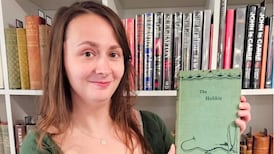Its claims for gargantuan attendances might border on the phantasmagorical, but Fleadh Cheoil na hÉireann 2007 has its eye on a prize that'd be the envy of many a traditional music gathering, from Gweedore to Miltown Malbay and possibly even as far afield as Tokyo (which boasts one of the biggest local Comhaltas Ceoltóirí Éireann branches in the world, with several hundred members).
Even if they don't attract their widely-trumpeted 250,000 punters, fleadh 2007 aims to bag a world record tonight by hosting the world's biggest traditional music session in Tullamore's O'Connor Square at 8pm.
Their goal is to get up to 2,000 musicians all playing the same tunes at the same time, with such stalwart session tunes as The Geese In The Bog, and probably, such family favourites as Jenny's Chickensand I Buried My Wife And Danced On Top Of Her.
While some people are still of the opinion that the best way to play a bodhrán is with a penknife, and others are prone to breaking out in a rash at the sight and sound of a battalion of box players playing in unison - and in competition - comhaltas's annual flagship event has set its sights high with nary a nod in the direction of the begrudgers.
Attracta Brady, a musician and fleadh 2007's chairwoman, already has a fire in her belly with this year's Scoil Éigse (an annual week-long traditional music school which precedes the weekend competition of the fleadh) attracting over 800 students.
The fleadh's location changes annually and this is the first time it has returned to the midlands since the Mullingar fleadh of 1963.
Brady, a fiddle and flute player, and a past participant of the fleadh's annual competitions herself, sees the competitors as the lifeblood of what is now an annual event in the calendars of musicians from Ireland, the UK, the US and in latter years, Australia, China and Japan.
"Irish traditional music has developed beyond our wildest imagination," Brady enthuses. "It's so popular that it's cool to be a traditional musician nowadays. When I was going to school in the '70s and '80s, I was taunted because I played Irish music but it really has come full circle now."
With so many summer schools, festivals and sessions jostling for attention throughout the summer months in particular, it's a wonder that the fleadh hasn't been relegated to playing second fiddle to other events. Brady is unequivocal in her conviction that the fleadh is a unique event.
"I think it simply leads the posse by a long shot," she declares. "Many of these musicians will stay in Tullamore for up to 10 days to take part in Scoil Éigse, the competitions, and to swap tunes with one another. In fact, in recent years, the competitions have grown so big that qualifying rounds were introduced. Now we have 44 county and regional fleadhs all culminating in this all-Ireland fleadh.
"In other music festivals, you don't have the community musicians to the fore. You have the professional musicians, who may not be as good as some of the musicians we have here at the fleadh. It's the platform that the fleadh gives to every musician, regardless of their creed or race that sets it apart from everything else."
This year's fleadh will host 2,000 competitors who've come through gruelling local and regional finals. They are the elite of the traditional music world, and can count among their ranks Michael Flatley, Matt Molloy, John Carty and Martin Hayes. Brady has no idea how many musicians in total take part in all of the qualifying rounds of the fleadh, but she figures it's a master's thesis waiting in the wings for the attention of an enthusiastic scholar.
For the first time, the fleadh kicks off this year with an opening parade of all the musicians in O'Connor Square at 7pm this evening. It's a doffing of the fleadh's cap to musicians who have fuelled the event since it was founded 56 years ago.











